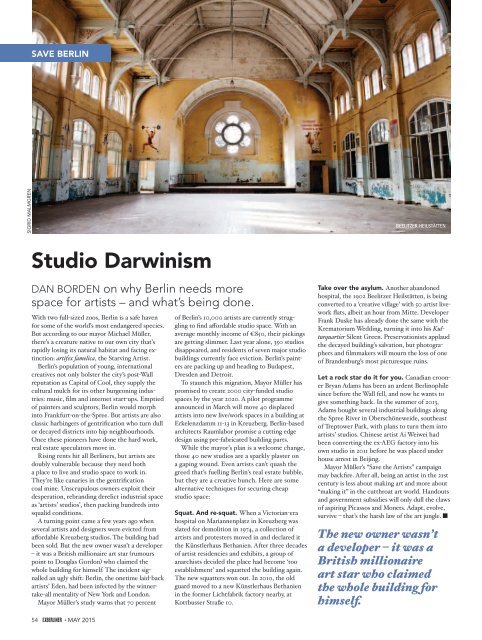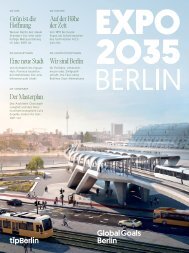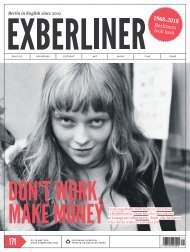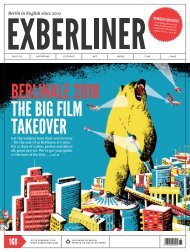Create successful ePaper yourself
Turn your PDF publications into a flip-book with our unique Google optimized e-Paper software.
ARTICLE SAVE BERLIN TAG<br />
SIGRID MALMGREN<br />
BEELITZER HEILSTÄTTEN<br />
Studio Darwinism<br />
DAN BORDEN on why Berlin needs more<br />
space for artists – and what’s being done.<br />
With two full-sized zoos, Berlin is a safe haven<br />
for some of the world’s most endangered species.<br />
But according to our mayor Michael Müller,<br />
there’s a creature native to our own city that’s<br />
rapidly losing its natural habitat and facing extinction:<br />
artifex famelica, the Starving Artist.<br />
Berlin’s population of young, international<br />
creatives not only bolster the city’s post-Wall<br />
reputation as Capital of Cool, they supply the<br />
cultural mulch for its other burgeoning industries:<br />
music, film and internet start-ups. Emptied<br />
of painters and sculptors, Berlin would morph<br />
into Frankfurt-on-the-Spree. But artists are also<br />
classic harbingers of gentrification who turn dull<br />
or decayed districts into hip neighbourhoods.<br />
Once these pioneers have done the hard work,<br />
real estate speculators move in.<br />
Rising rents hit all Berliners, but artists are<br />
doubly vulnerable because they need both<br />
a place to live and studio space to work in.<br />
They’re like canaries in the gentrification<br />
coal mine. Unscrupulous owners exploit their<br />
desperation, rebranding derelict industrial space<br />
as ‘artists’ studios’, then packing hundreds into<br />
squalid conditions.<br />
A turning point came a few years ago when<br />
several artists and designers were evicted from<br />
affordable Kreuzberg studios. The building had<br />
been sold. But the new owner wasn’t a developer<br />
– it was a British millionaire art star (rumours<br />
point to Douglas Gordon) who claimed the<br />
whole building for himself. The incident signalled<br />
an ugly shift: Berlin, the onetime laid-back<br />
artists’ Eden, had been infected by the winnertake-all<br />
mentality of New York and London.<br />
<strong>May</strong>or Müller’s study warns that 70 percent<br />
of Berlin’s 10,000 artists are currently struggling<br />
to find affordable studio space. With an<br />
average monthly income of €850, their pickings<br />
are getting slimmer. Last year alone, 350 studios<br />
disappeared, and residents of seven major studio<br />
buildings currently face eviction. Berlin’s painters<br />
are packing up and heading to Budapest,<br />
Dresden and Detroit.<br />
To staunch this migration, <strong>May</strong>or Müller has<br />
promised to create 2000 city-funded studio<br />
spaces by the year 2020. A pilot programme<br />
announced in March will move 40 displaced<br />
artists into new live/work spaces in a building at<br />
Erkelenzdamm 11-13 in Kreuzberg. Berlin-based<br />
architects Raumlabor promise a cutting edge<br />
design using pre-fabricated building parts.<br />
While the mayor’s plan is a welcome change,<br />
those 40 new studios are a sparkly plaster on<br />
a gaping wound. Even artists can’t quash the<br />
greed that’s fuelling Berlin’s real estate bubble,<br />
but they are a creative bunch. Here are some<br />
alternative techniques for securing cheap<br />
studio space:<br />
Squat. And re-squat. When a Victorian-era<br />
hospital on Mariannenplatz in Kreuzberg was<br />
slated for demolition in 1974, a collection of<br />
artists and protesters moved in and declared it<br />
the Künstlerhaus Bethanien. After three decades<br />
of artist residencies and exhibits, a group of<br />
anarchists decided the place had become ‘too<br />
establishment’ and squatted the building again.<br />
The new squatters won out. In 2010, the old<br />
guard moved to a new Künstlerhaus Bethanien<br />
in the former Lichtfabrik factory nearby, at<br />
Kottbusser Straße 10.<br />
Take over the asylum. Another abandoned<br />
hospital, the 1902 Beelitzer Heilstätten, is being<br />
converted to a ‘creative village’ with 50 artist livework<br />
flats, albeit an hour from Mitte. Developer<br />
Frank Duske has already done the same with the<br />
Krematorium Wedding, turning it into his Kulturquartier<br />
Silent Green. Preservationists applaud<br />
the decayed building’s salvation, but photographers<br />
and filmmakers will mourn the loss of one<br />
of Brandenburg’s most picturesque ruins.<br />
Let a rock star do it for you. Canadian crooner<br />
Bryan Adams has been an ardent Berlinophile<br />
since before the Wall fell, and now he wants to<br />
give something back. In the summer of 2013,<br />
Adams bought several industrial buildings along<br />
the Spree River in Oberschöneweide, southeast<br />
of Treptower Park, with plans to turn them into<br />
artists’ studios. Chinese artist Ai Weiwei had<br />
been converting the ex-AEG factory into his<br />
own studio in 2011 before he was placed under<br />
house arrest in Beijing.<br />
<strong>May</strong>or Müller’s “Save the Artists” campaign<br />
may backfire. After all, being an artist in the 21st<br />
century is less about making art and more about<br />
“making it” in the cutthroat art world. Handouts<br />
and government subsidies will only dull the claws<br />
of aspiring Picassos and Monets. Adapt, evolve,<br />
survive – that’s the harsh law of the art jungle. ■<br />
The new owner wasn’t<br />
a developer – it was a<br />
British millionaire<br />
art star who claimed<br />
the whole building for<br />
himself.<br />
54 • MAY <strong>2015</strong>


















